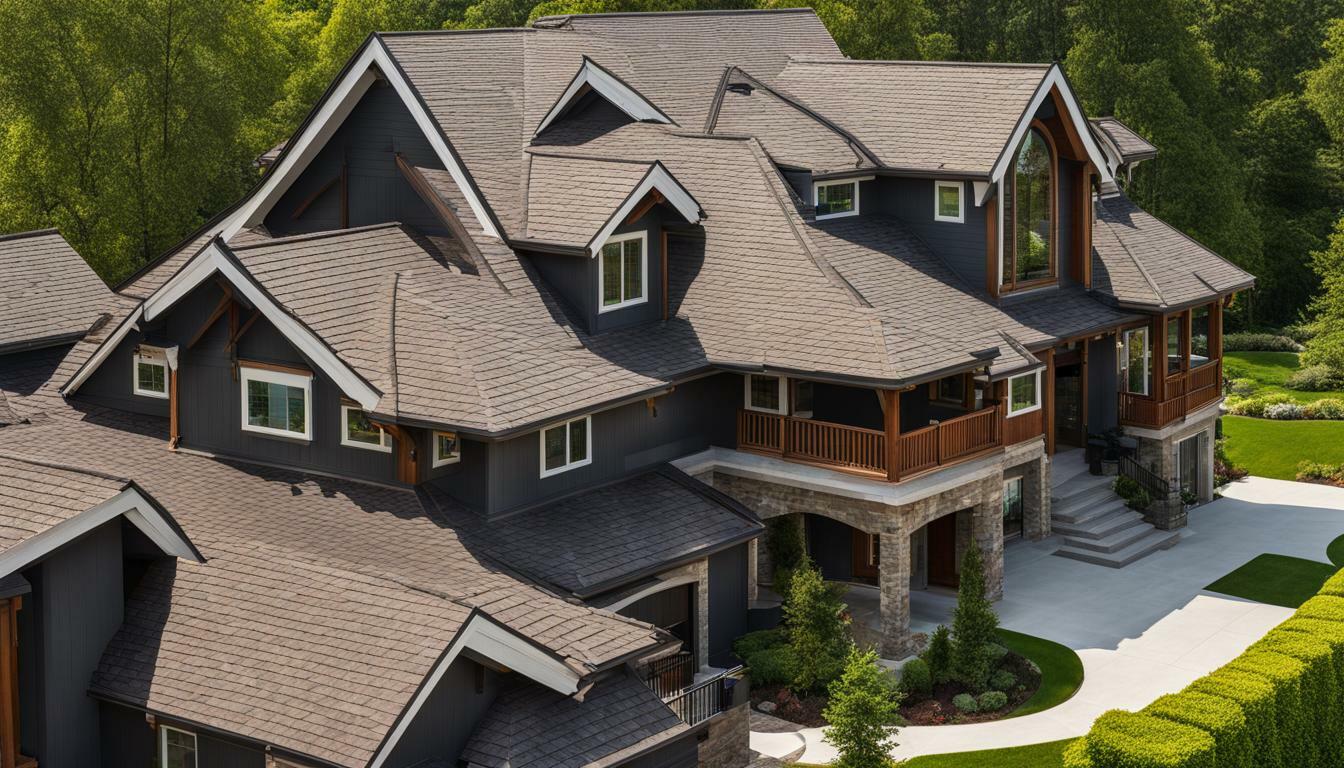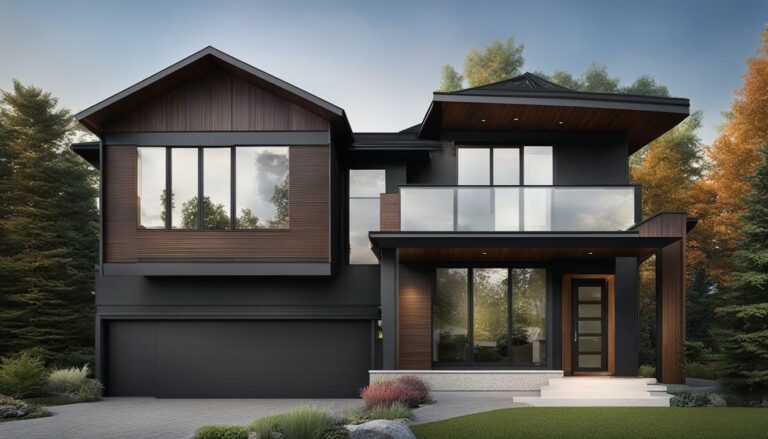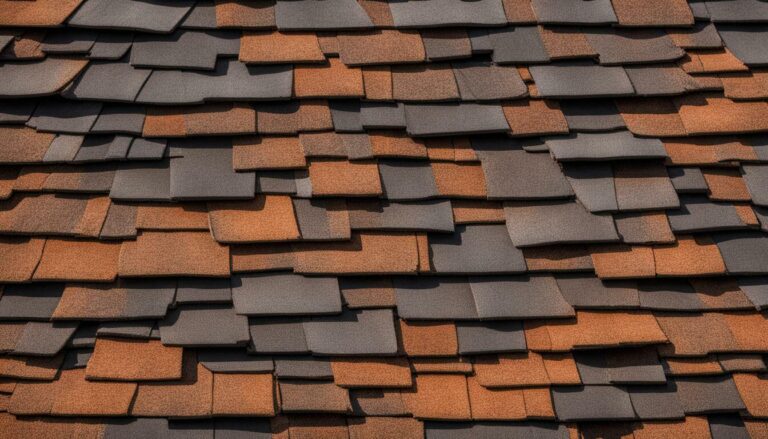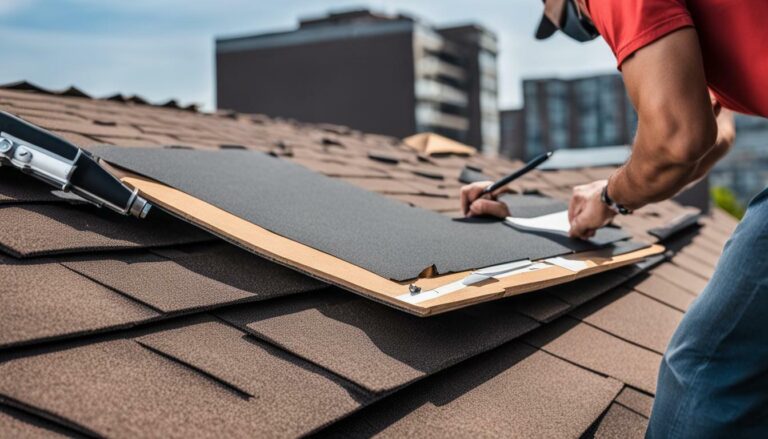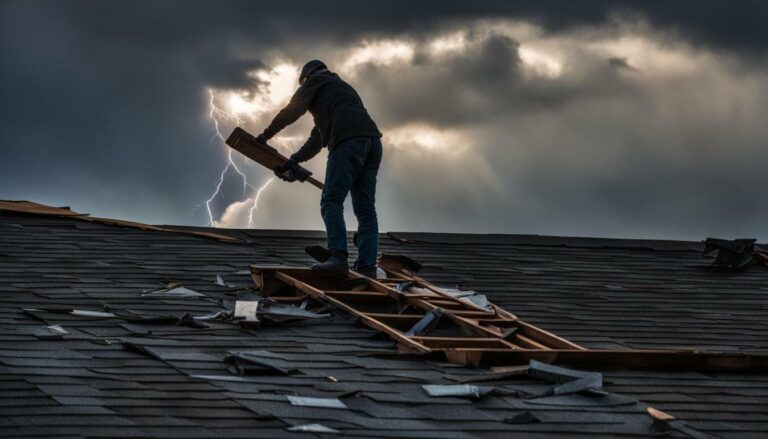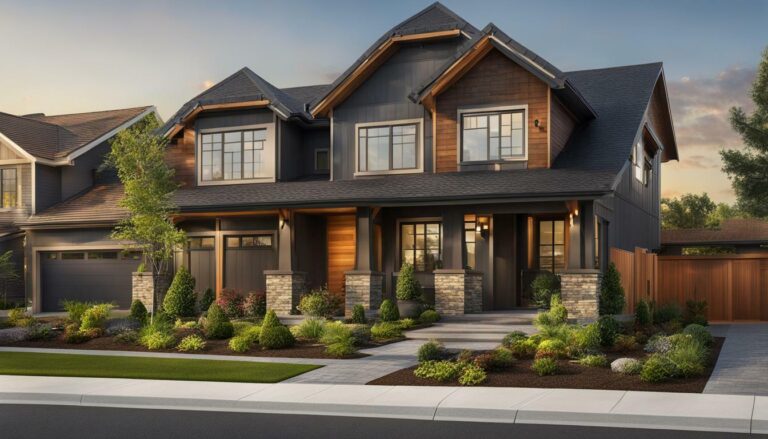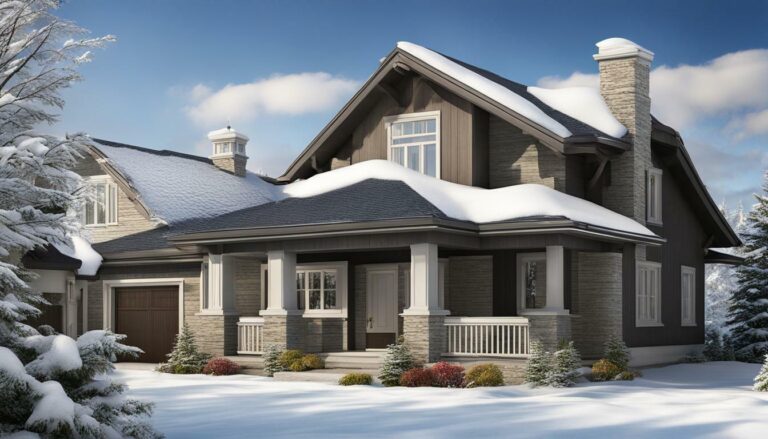Mastering Roof Pitch and Material Selection for Your Home
When it comes to ensuring the durability, efficiency, and curb appeal of your home, mastering roof pitch and material selection is essential. Your roof pitch is a critical factor in the success of a residential roofing replacement project. Understanding the difference between pitch and slope is crucial, as pitch measures the rise of the roof against the span, while slope measures the rise against the run.
Choosing the right roof pitch is just the first step. The materials you select for your roof also play a vital role in its overall performance. Proper rainwater drainage is essential to avoid potential damage and ensure the longevity of your roofing system.
In this article, we will explore the different roof types, materials, and their compatibility with various pitch ranges. We will also discuss the advantages of steep-pitched roofs, such as improved rainwater shedding and the potential for additional living space. Additionally, we will explore the suitability of shallow-pitched roofs for single-story homes in high-wind areas.
By the end of this article, you will have a comprehensive understanding of the importance of roof pitch and material selection, as well as the factors to consider when choosing the right roof materials for your home. Let’s dive in!
- Understanding the difference between roof pitch and slope is crucial in residential roofing.
- Steep-pitched roofs offer benefits such as improved rainwater shedding and the potential for additional living space.
- Shallow-pitched roofs can be suitable for single-story homes in high-wind areas.
- Proper rainwater drainage is essential for the longevity of your roofing system.
- Consider the factors of durability, energy efficiency, maintenance requirements, and aesthetic appeal when choosing the right roof material.
Understanding Roof Pitch: The Key to a Successful Roofing Replacement
Before diving into the world of roof material selection, it is crucial to grasp the fundamentals of roof pitch and how it influences your roofing decisions. Roof pitch refers to the slope or angle of a roof, and it plays a significant role in determining the type of materials suitable for your home. Understanding the difference between pitch and slope is essential, as it helps you make informed choices when replacing your roof.
Roof pitch is measured by the rise of the roof against its span. In simpler terms, it is the vertical height of the roof divided by its horizontal length. This measurement is crucial because it affects various aspects of your roofing system, including structural integrity, aesthetics, and water drainage.
A steep-pitched roof, characterized by a high angle, offers several advantages. For one, it provides better visibility and enhances the overall aesthetics of your home. Additionally, the steep slope allows for effective rainwater shedding, reducing the risk of leaks and water damage. Moreover, steep-pitched roofs provide the opportunity to convert your attic space into usable living areas, expanding your home’s functionality and value.
On the other hand, shallow-pitched roofs, commonly found in commercial properties, can also be suitable for single-story homes in high-wind areas. While not as visually striking as steep-pitched roofs, shallower slopes offer their own set of benefits. They provide a more streamlined appearance and are often more cost-effective. In areas prone to strong winds, shallow-pitched roofs can offer better resistance and prevent potential damage.
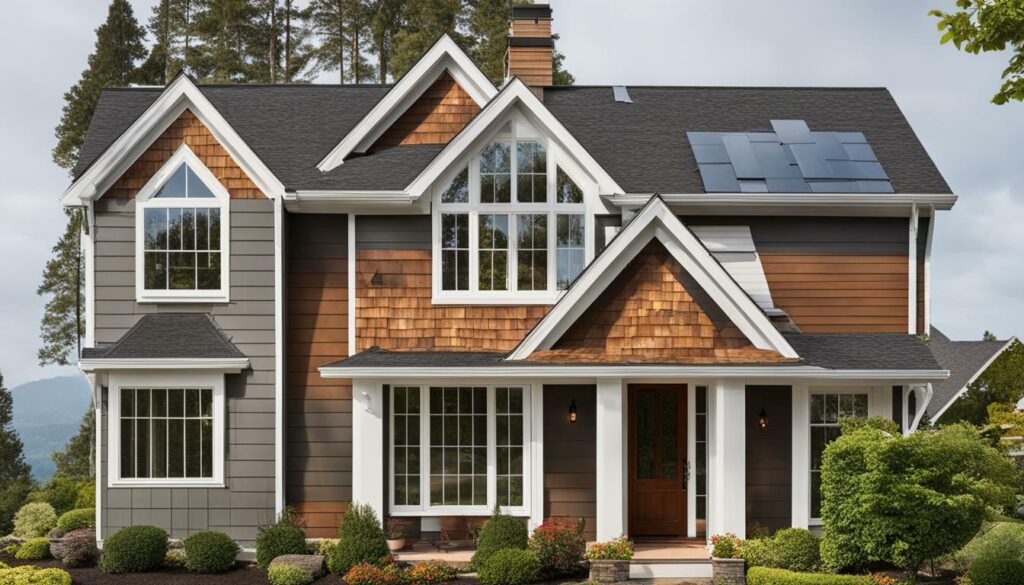
When selecting a roof pitch, it is important to consider the materials that allow for proper rainwater drainage. A steep-pitched roof, combined with suitable roof materials, ensures that water flows down quickly and effectively, preventing pooling or stagnant water. On the other hand, shallow-pitched roofs require materials that can handle slower water drainage to avoid potential water damage.
Choosing the right roof material is equally important in maintaining the longevity and efficiency of your roof. Factors such as durability, energy efficiency, maintenance requirements, and aesthetic appeal should all be taken into account. By understanding roof pitch and material compatibility, you can achieve a balanced roof that not only protects your home but also enhances its curb appeal.
Benefits of Steep-Pitched Roofs: Durability, Living Space, and Rainwater Shedding
Choosing a steep-pitched roof for your home can bring multiple benefits that go beyond just aesthetics. One of the advantages is increased durability. The steeper the pitch, the better the roof’s ability to withstand harsh weather conditions, such as heavy snowfall or high winds. This is due to the angle of the roof, which allows snow and debris to slide off easily, preventing excessive weight that could potentially cause damage. Additionally, the steep slope helps prevent water from pooling on the roof, reducing the risk of leaks and moisture-related issues.
Another advantage of steep-pitched roofs is the potential for extra living space. The steep angle creates a taller attic area, giving homeowners the opportunity to convert it into usable living space. This additional square footage can be utilized as a bedroom, office, or storage area, adding value and functionality to the home. It provides an excellent solution for homeowners who are looking to maximize their living area without the need for an extensive home expansion project.
Improved rainwater shedding is yet another benefit of choosing a steep-pitched roof. The steep slope allows rainwater to quickly and efficiently drain off the roof, preventing water accumulation and potential water damage. Proper rainwater shedding is crucial for maintaining the integrity of the roof and preventing issues such as leaks or mold growth. By ensuring effective water drainage, steep-pitched roofs contribute to the overall longevity and performance of the roofing system.
| Benefits of Steep-Pitched Roofs | Description |
|---|---|
| Durability | Steeper pitches offer better resistance against harsh weather conditions, reducing the risk of damage. |
| Living Space | The taller attic space created by a steep-pitched roof can be converted into usable living space. |
| Rainwater Shedding | Steep pitches facilitate efficient rainwater drainage, preventing water accumulation and potential damage. |
Overall, choosing a steep-pitched roof not only enhances the visual appeal of your home but also provides long-term benefits such as increased durability, additional living space, and improved rainwater shedding. When planning a residential roofing project, it is important to consider these advantages and consult with a professional to determine the most suitable roof pitch for your specific needs.
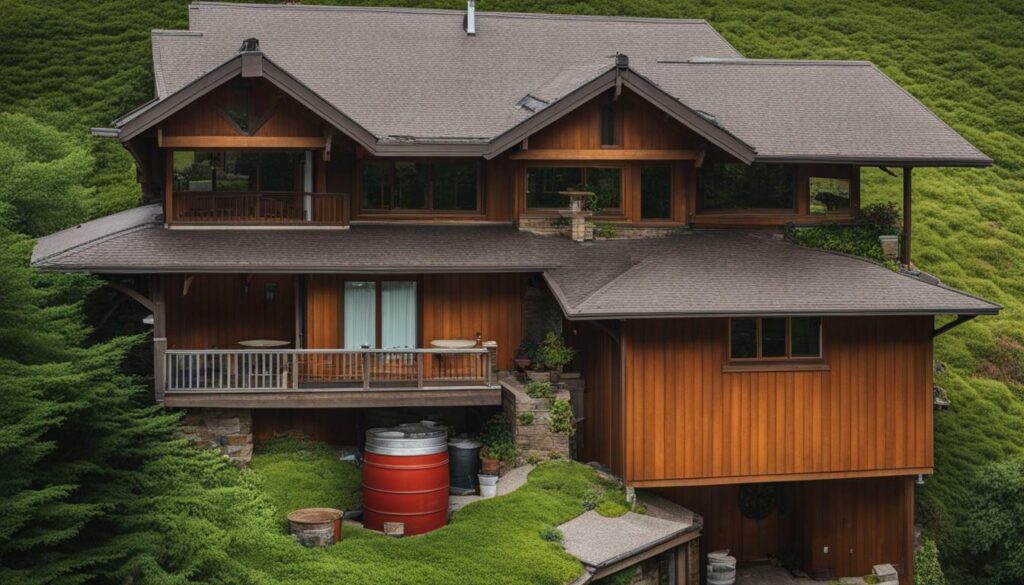
Shallow-Pitched Roofs for High-Wind Areas: Commercial Properties and Single-Story Homes
While steep-pitched roofs are often preferred, shallow pitches can be a suitable choice for single-story homes in high-wind areas or for those looking for a specific architectural style. Shallow-pitched roofs, characterized by a low slope, offer unique advantages that make them worth considering.
One of the main benefits of shallow-pitched roofs is their ability to withstand high winds. In high-wind areas, the wind exerts significant pressure on the roof, making it crucial to choose a design that can effectively resist these forces. Shallow-pitched roofs have a lower profile, reducing the surface area that is exposed to strong gusts. This design feature allows for better wind resistance, making them a practical option for homes in such areas.
Additionally, shallow-pitched roofs are commonly found in commercial properties due to their modern and sleek appearance. The clean lines and minimalistic style of these roofs can significantly enhance the overall aesthetic appeal of a building. Their contemporary design makes them an attractive choice for homeowners seeking a unique architectural statement.
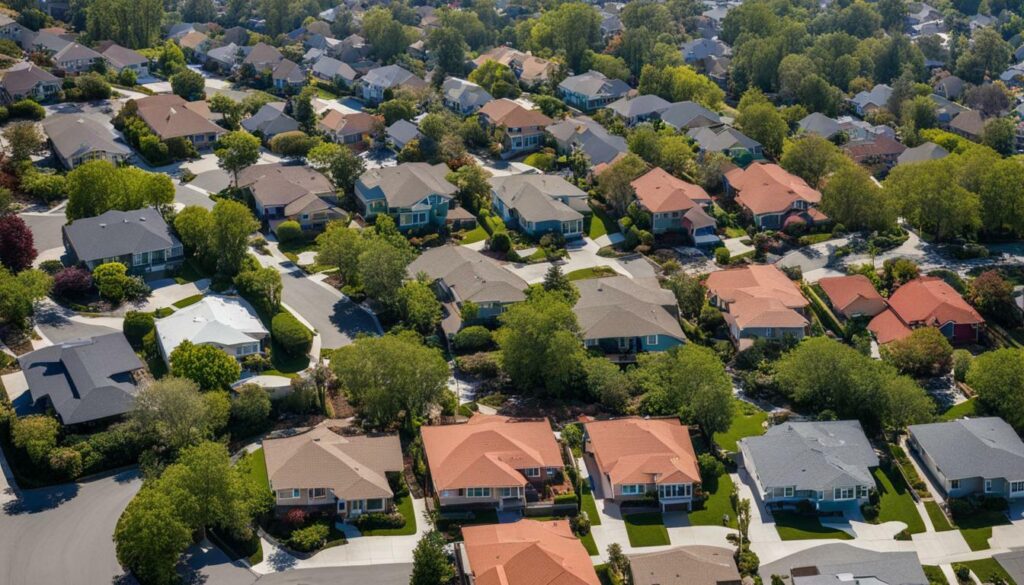
| Advantages of Shallow-Pitched Roofs for High-Wind Areas: |
|---|
| 1. Improved wind resistance compared to higher-pitched roofs. |
| 2. Lower profile design reduces surface area exposed to strong gusts. |
| 3. Modern and sleek appearance suitable for commercial properties. |
| 4. Allows for unique architectural styles and statements. |
Is a Shallow-Pitched Roof Right for You?
Whether you’re considering a shallow-pitched roof for your single-story home in a high-wind area or you simply want to achieve a specific architectural style, it’s important to assess your specific needs and consult with a professional roofing contractor. They can help you determine the most suitable roof pitch for your home, considering factors such as local weather conditions, building codes, and aesthetic preferences.
Remember, choosing the right roof for your home is a significant decision that can impact its durability, energy efficiency, and overall appeal. By carefully considering the advantages of shallow-pitched roofs and consulting with experts, you can make an informed choice that suits your needs and enhances the beauty of your home.
The Importance of Proper Rainwater Drainage in Roof Material Selection
Ensuring proper rainwater drainage is a key factor in selecting the right roof material for your home, as it affects the longevity and performance of the entire roofing system. When rainwater does not flow off the roof effectively, it can lead to water pooling, leaks, and structural damage. Therefore, understanding the compatibility between roof pitch and material is essential in maintaining a durable and efficient roof.
One aspect to consider when selecting roof materials is their ability to handle different levels of water runoff. Steep-pitched roofs, with their steeper angles, allow rainwater to quickly shed off, minimizing the risk of water accumulation. Materials such as asphalt shingles and metal roofing are commonly used on steep-pitched roofs due to their excellent water-shedding capabilities.
On the other hand, shallow-pitched roofs require materials that can still effectively manage rainwater, albeit with a lower pitch angle. Single-story homes in high-wind areas often benefit from shallow-pitched roofs, as they offer better wind resistance. The use of materials like clay tiles or concrete can provide adequate water drainage while maintaining structural integrity in such conditions.
| Roof Pitch | Ideal Materials |
|---|---|
| Steep-pitched | Asphalt shingles, metal roofing |
| Shallow-pitched | Clay tiles, concrete |
Choosing the right roof material that is compatible with your roof pitch is crucial for protecting your home from water damage and ensuring its long-term durability. It is recommended to consult with roofing professionals who can assess your roof’s pitch, local climate conditions, and recommend the most suitable materials for your specific needs.
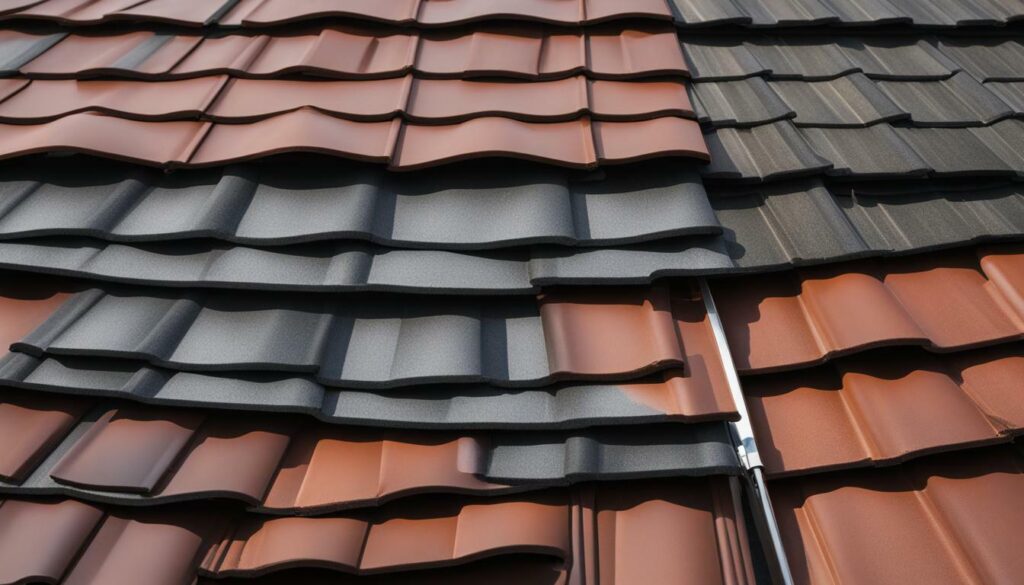
- Rainwater drainage is a significant factor to consider when selecting roof materials.
- Steep-pitched roofs are ideal for quick rainwater shedding, while shallow-pitched roofs require materials that can handle water runoff effectively.
- Asphalt shingles and metal roofing are commonly used for steep-pitched roofs, while clay tiles or concrete are suitable for shallow pitches.
- Consulting with roofing professionals can help determine the best roof material for your specific roof pitch and local climate conditions.
Exploring Different Roof Types: Matching Pitch with Material Compatibility
To achieve a harmonious and functional roofing system, it is crucial to select a roof type that matches the pitch of your home. The pitch of a roof refers to the angle or slope, while the roof type determines the material and design. Different roof types have varying degrees of compatibility with specific pitches, ensuring optimal performance and longevity.
One of the most common roof types is the gable roof, which features two sloping sides that meet at a ridge. Gable roofs are versatile and can accommodate a wide range of pitches, making them suitable for various architectural styles. They are compatible with many roofing materials, including asphalt shingles, metal roofing, and clay tiles.
For lower pitches, such as those found in colonial or cottage-style homes, a hip roof might be a better option. Hip roofs have slopes on all four sides, creating a pyramid-like structure. They provide added stability and are compatible with materials like asphalt shingles, standing seam metal, or even cedar shakes. Their design also makes them resilient against strong winds and helps with rainwater drainage.
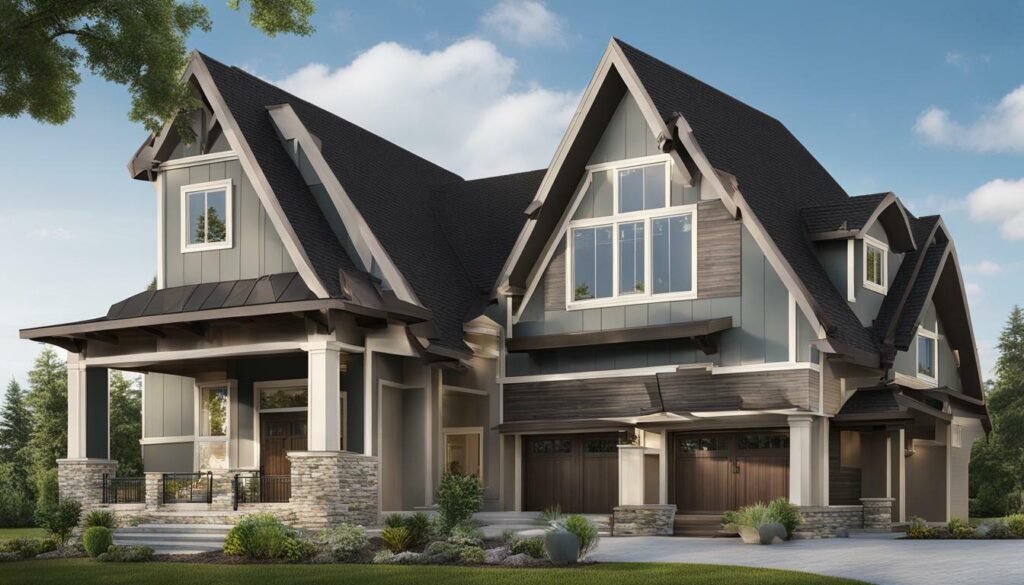
For those seeking a more modern and aesthetically pleasing option, a flat or low-slope roof might be the answer. These roofs have a pitch of less than 10 degrees and require specific materials that can withstand ponding water and provide superior waterproofing. Flat roofs are commonly used in commercial properties but can also be suitable for residential applications, especially for contemporary or minimalist designs.
When choosing a roof type, it’s essential to consider factors such as climate, architectural style, and personal preferences. Consulting with roofing professionals can help determine which roof type is best suited for your specific needs and pitch range. By selecting the right roof type and ensuring material compatibility, you can achieve a roofing system that not only enhances the curb appeal of your home but also offers durability and long-term performance.
| Roof Type | Compatible Pitches | Recommended Materials |
|---|---|---|
| Gable Roof | Various pitches | Asphalt shingles, metal roofing, clay tiles |
| Hip Roof | Lower pitches | Asphalt shingles, standing seam metal, cedar shakes |
| Flat or Low-Slope Roof | Pitch of less than 10 degrees | Modified bitumen, EPDM, TPO |
Factors to Consider When Choosing the Right Roof Material
Selecting the right roof material involves careful consideration of several factors to ensure long-term satisfaction and performance. When making this important decision, you need to take into account the climate in your area, the durability and maintenance requirements of different materials, as well as the aesthetic appeal that will enhance the overall look of your home.
One factor to consider is the weather conditions in your region. If you live in an area with frequent rainstorms or snowfall, you’ll want to choose a roof material that is highly resistant to water damage and can efficiently shed rain and snow. On the other hand, if you reside in a hot and sunny location, selecting a material with good heat resistance and UV protection will help keep your home cool and reduce energy costs.
The durability and maintenance requirements of different roof materials should also be taken into account. Some materials, such as asphalt shingles, require regular inspection and maintenance to prevent leaks and prolong their lifespan. Others, like metal roofing, are known for their durability and low maintenance needs. Consider your willingness and ability to perform regular maintenance tasks when selecting the right roof material.
Lastly, don’t overlook the importance of aesthetics. Your roof is a significant part of your home’s exterior, and choosing the right material can greatly enhance its overall curb appeal. Consider the architectural style of your home and select a roof material that complements its design. Whether you prefer the classic look of clay tiles, the sleek appearance of metal roofing, or the versatility of asphalt shingles, finding a material that matches your personal taste and enhances your home’s aesthetic appeal is crucial.
| Factors to Consider | Rainfall and Snowfall | Climate and Heat Resistance | Durability and Maintenance | Aesthetic Appeal |
|---|---|---|---|---|
| Material Options | Water-resistant materials, such as metal roofing and slate tiles | Heat-resistant materials, such as clay tiles and metal roofing | Durable materials with low maintenance needs, such as metal roofing and concrete tiles | Various options to match different architectural styles and personal preferences |
| Pros | Efficient rain and snow shedding | Heat reflectivity and energy efficiency | Long lifespan and minimal maintenance | Enhanced curb appeal and customization |
| Cons | Costlier compared to standard materials | Potential heat absorption and higher energy costs | Higher upfront costs for premium materials | Additional cost for customization and specialty materials |
The decision-making process
- Assess the weather conditions and climate in your area.
- Evaluate the durability and maintenance requirements of different materials.
- Consider the aesthetic appeal and architectural style of your home.
- Weigh the pros and cons of each material.
- Consult with a professional roofing contractor for expert advice.
Remember that selecting the right roof material is an investment that plays a significant role in protecting your home and enhancing its overall appearance. Take your time to research and consider all the factors mentioned above to ensure you make an informed decision that meets your needs and preferences.
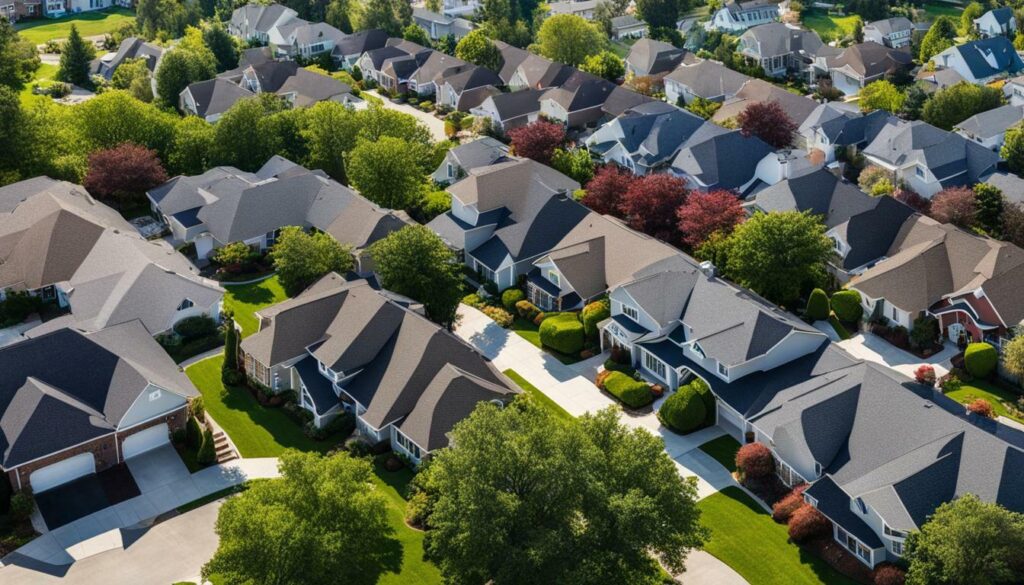
The Top Roof Materials for Different Pitch Ranges.
From traditional asphalt shingles to modern metal roofing, there is a wide range of materials available to match the pitch of your roof and meet your specific needs. When selecting the right roof material, it is essential to consider factors such as durability, maintenance requirements, energy efficiency, and aesthetic appeal. Here are some top roof materials recommended for different pitch ranges:
1. Low-Pitched Roofs (0-3:12)
For low-pitched roofs, use materials that provide excellent waterproofing and can withstand pooling water. One popular option is built-up roofing (BUR) systems, which consist of multiple layers of bitumen and reinforcing fabric. BUR systems create a durable, seamless surface that protects against water penetration.
Another suitable choice for low-pitched roofs is thermoplastic polyolefin (TPO) roofing. TPO roofs offer excellent UV resistance, flexibility, and energy efficiency. The heat-welded seams provide superior strength and durability, making them ideal for low-pitched roofs.
2. Medium-Pitched Roofs (4-9:12)
Asphalt shingles are a popular choice for medium-pitched roofs due to their versatility, affordability, and ease of installation. They come in various styles and colors, allowing homeowners to achieve the desired aesthetic for their homes. Asphalt shingles also provide reliable protection against harsh weather conditions.
Metal roofing is another excellent option for medium-pitched roofs. It offers exceptional durability, longevity, and energy efficiency. Metal roofs can withstand high winds, shed snow easily, and reflect heat, reducing energy costs. They are available in different styles, including standing seam, metal tiles, and metal shakes.
3. Steep-Pitched Roofs (10:12 and above)
Steep-pitched roofs require materials that offer superior water shedding and wind resistance. Clay or concrete tiles are popular choices for steep-pitched roofs due to their timeless beauty and exceptional durability. They can withstand extreme weather conditions and can last for decades with proper maintenance.
Slate roofing is another premium option for steep-pitched roofs. It is highly resistant to fire, wind, and moisture, making it an excellent choice for homeowners seeking unparalleled durability. Slate roofs are available in a variety of colors and can add a touch of elegance to any home.
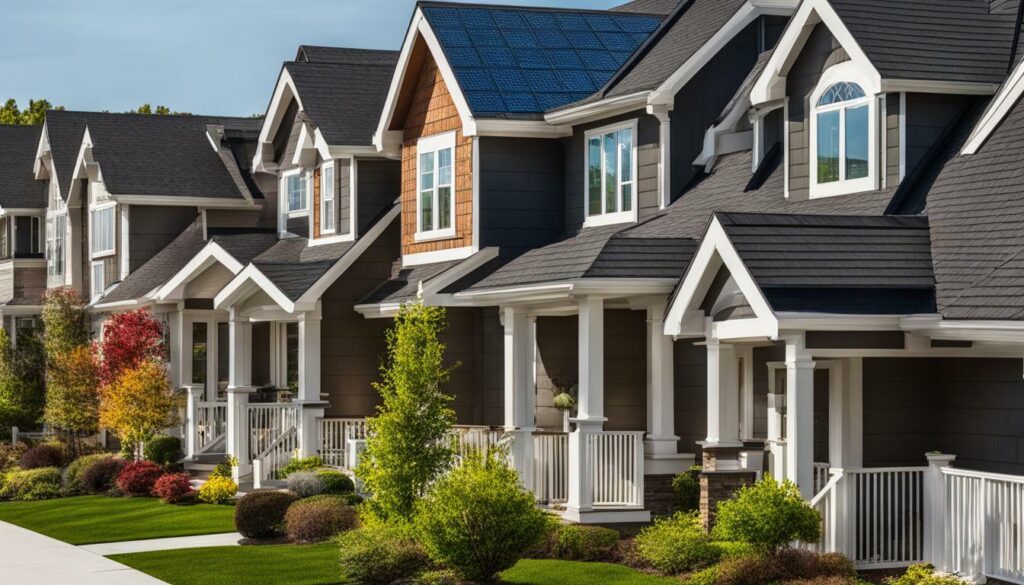
| Roof Pitch Range | Recommended Roof Materials |
|---|---|
| 0-3:12 | Built-Up Roofing (BUR), Thermoplastic Polyolefin (TPO) |
| 4-9:12 | Asphalt shingles, Metal roofing |
| 10:12 and above | Clay or concrete tiles, Slate roofing |
Achieving a Balanced Roof: Blending Aesthetics, Durability, and Efficiency
Creating a harmonious blend of aesthetics, durability, and efficiency is the ultimate goal when selecting the right roof material for your home. Your roof not only protects your property from the elements but also contributes to the overall curb appeal and energy efficiency. With a wide range of roof materials available, it’s important to carefully consider your priorities and make an informed decision.
When it comes to aesthetics, choose a roof material that complements your home’s architectural style. Whether you prefer the timeless elegance of clay tiles, the sleek look of metal roofing, or the versatility of asphalt shingles, select a material that enhances the visual appeal of your property. Consider the color options, texture, and overall design to achieve a cohesive look.
Durability is another crucial factor to consider. Your roof should be able to withstand the weather conditions in your area and provide long-lasting protection. Look for materials that are known for their durability, such as metal roofing or concrete tiles. These materials are resistant to extreme temperatures, high winds, and other environmental factors, ensuring that your roof will stand the test of time.
Efficiency is becoming increasingly important in today’s environmentally conscious society. Choose a roof material that offers energy-saving features, such as solar reflective coatings or insulation properties. These features can help reduce your energy consumption, lower utility bills, and create a more comfortable living environment. Additionally, consider the maintenance requirements of the different materials to ensure that your roof remains efficient and performs optimally throughout its lifespan.
| Roof Material | Aesthetics | Durability | Efficiency |
|---|---|---|---|
| Clay Tiles | Elegant and timeless | Durable and resistant to weathering | Naturally insulating properties |
| Metal Roofing | Sleek and modern | Highly durable and long-lasting | Reflective coatings for energy efficiency |
| Asphalt Shingles | Versatile and cost-effective | Durable with proper maintenance | Options for solar reflective shingles |
By considering the aesthetics, durability, and efficiency of different roof materials, you can select the best option that meets your needs and enhances the overall value of your home. Consult with a professional roofing contractor to further explore your options and ensure that your choice aligns with your specific requirements. Remember, a balanced roof not only protects your home but also adds beauty and value for years to come.

Mastering roof pitch and material selection can significantly impact the overall performance and visual appeal of your home, so take the time to make informed decisions that will stand the test of time.
Understanding the difference between roof pitch and slope is crucial in planning a residential roofing replacement. While pitch measures the rise of the roof against the span, slope measures the rise against the run. This knowledge will help you choose the right roof material that is compatible with your roof’s pitch, ensuring proper rainwater drainage and longevity.
Steep-pitched roofs offer numerous benefits for homeowners. Not only do they provide better visibility, but they also allow the possibility of converting your attic into usable living space. Additionally, steep pitches excel at shedding rainwater, preventing water damage and maintaining the structural integrity of your home.
Alternatively, shallow-pitched roofs, commonly found in commercial properties, can also be suitable for single-story homes in high-wind areas. It is important to consider the specific circumstances and needs of your home when selecting a roof pitch, as it can affect the durability and performance of your roof in challenging weather conditions.
When choosing a roof material, it is essential to prioritize proper rainwater drainage. Opting for materials that are compatible with your roof’s pitch will ensure efficient water runoff, preventing any potential issues such as leaks or moisture-related damage. Consider factors such as durability, energy efficiency, maintenance requirements, and aesthetic appeal to create a balanced roof that meets your home’s unique needs.
By mastering roof pitch and material selection, you can create a roof that not only protects your home but also enhances its curb appeal. Take the time to research and consult with professionals to make informed decisions that will result in a beautiful, long-lasting roof for your home.
FAQ
Q: What is the difference between pitch and slope?
A: Pitch measures the rise of the roof against the span, while slope measures the rise against the run.
Q: What are the benefits of steep-pitched roofs?
A: Steep-pitched roofs offer better visibility, the potential for converting the attic into living space, and improved rainwater shedding capabilities.
Q: Can shallow-pitched roofs be suitable for homes in high-wind areas?
A: Yes, shallow-pitched roofs can be a viable option for single-story homes in high-wind areas.
Q: Why is proper rainwater drainage important in roof material selection?
A: Proper rainwater drainage is important to prevent water damage and ensure the longevity of the roof.
Q: How do I select the right roof material for my home?
A: Consider factors such as durability, energy efficiency, maintenance requirements, and aesthetic appeal when choosing the right roof material.
Q: Which roof materials are recommended for different pitch ranges?
A: Popular roof materials such as asphalt shingles, metal roofing, and clay tiles are suitable for various pitch ranges.
Q: How can I achieve a balanced roof that combines aesthetics, durability, and efficiency?
A: Choose roof options that strike the right balance between aesthetics, durability, and energy efficiency for your home.
